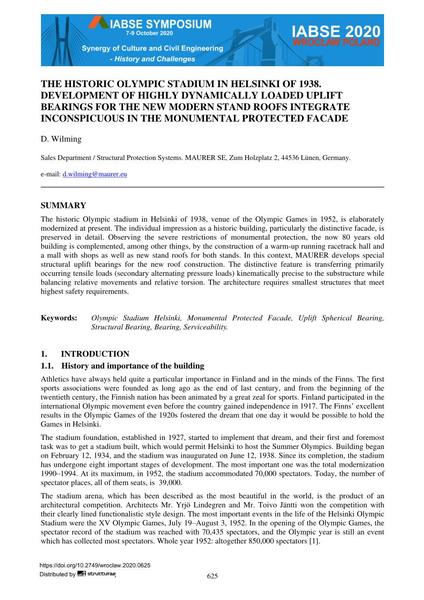The Historic Olympic Stadium in Helsinki of 1938. Development of Highly Dynamically Loaded Uplift Bearings for the new Modern Stand Roofs Integrate Inconspicuous in the Monumental Protected Facade

|
|
|||||||||||
Bibliografische Angaben
| Autor(en): |
D. Wilming
|
||||
|---|---|---|---|---|---|
| Medium: | Tagungsbeitrag | ||||
| Sprache(n): | Englisch | ||||
| Tagung: | IABSE Symposium: Synergy of Culture and Civil Engineering – History and Challenges, Wrocław, Poland, 7-9 October 2020 | ||||
| Veröffentlicht in: | IABSE Symposium Wroclaw 2020 | ||||
|
|||||
| Seite(n): | 625-632 | ||||
| Anzahl der Seiten (im PDF): | 8 | ||||
| Jahr: | 2020 | ||||
| DOI: | 10.2749/wroclaw.2020.0625 | ||||
| Abstrakt: |
The historic Olympic stadium in Helsinki of 1938, venue of the Olympic Games in 1952, is elaborately modernized at present. The individual impression as a historic building, particularly the distinctive facade, is preserved in detail. Observing the severe restrictions of monumental protection, the now 80 years old building is complemented, among other things, by the construction of a warm-up running racetrack hall and a mall with shops as well as new stand roofs for both stands. In this context, MAURER develops special structural uplift bearings for the new roof construction. The distinctive feature is transferring primarily occurring tensile loads (secondary alternating pressure loads) kinematically precise to the substructure while balancing relative movements and relative torsion. The architecture requires smallest structures that meet highest safety requirements. |
||||
| Stichwörter: |
Brückenlager Gebrauchstauglichkeit
|
||||
